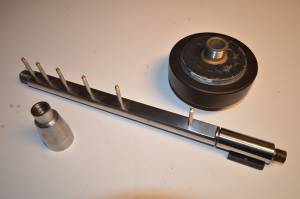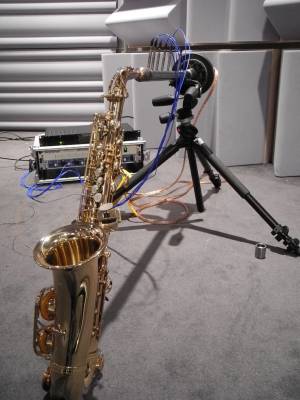Table of Contents
Hardware
- Impedance head with 6 PCB 377B10 Condenser Microphones and 426B03 Preamplifiers
- Calibration pipe (2 meters)
- Rack containing:
- RME Fireface 800 Audio Interface and cable
- Bryston 2B-LP Pro Amplifier (available but no longer used in general)
- various adaptors as needed
Software Installation
The measurement software is called zProbe. The current version is created as a Matlab graphical user interface. The audio i/o operations are handled using an RtAudio MEX package, which needs to be compiled from within Matlab.
The RME Fireface 800 driver must be installed properly.
Hardware connections
- The 6 microphones should be connected in order, the first one being located near the measurement plane. The PCB Piezotronics signal conditioner has lights that indicate if each of the microphone is connected. They can be used to determine which channel each cable is connected to.
- The outputs of the PCB conditioner are connected to the RME Fireface 800 using BNC-to-quarter-inch cables.
- Turn on the PCB signal conditioner and wait until the 6 microphone lights are off. Then turn on the RME Fireface.
- The RME Fireface is connected to the computer with a Firewire cable, a Firewire-to-Thunderbolt2 adaptor and a Thunderbolt2-to-Thunderbolt3 (USB-C) adaptor.
- The horn driver is connected to either the headphones output of the RME Fireface or to the Bryston amplifier output.
- If using the Bryston amplifier, the first output channel of the RME card must be connected to the amplifier using a quarter-inch-to-quarter-inch cable.
- If using the headphones output for the driver, connect the quarter-inch headphone jack directly to the driver and make sure the headphone gain knob is set to 5.
Software settings
- In Fireface Settings: Level In and Level Out should be -10 dBV and make sure that no special options are clicked on (such as the “Limiter”)
- In TotalMix: The Phones 1 output should be panned fully to the left and set for “Mono.” Check the Matrix View and click the matrix element that connects “AN 1/2” outputs to “Phones 1”. The output level for Phones 1 should be -10 dB.
- When calibrating and making measurements, monitor TotalMix to verify that all microphone channels are receiving a signal.
Operation
When starting a new measurement session, it is recommended that you create a new directory in which to store the calibration file and measurement results.
See the Help→zProbe Help menu item for more details.
Notes
The Fireface 800 software mixer, TotalMix, operation can be confusing. Consult the following TotalMix guide for some help. It is necessary to route the first analog output signal to the headphones output when using the output from the headphone jack.
If using the Bryston amplifier, the volume knob should be set to a fairly low value. If it is too loud, there will be distortion or you could blow out the speaker. If it is too low, the S/N ratio will be adversely affected.
Old Python software notes
The measurement software is called zProbe. The original version was written in the Python language and it was installed on the CAML laptop in C:\Users\caml\Documents\zProbe\. To execute ZProbe, you have to run […]ZProbe\src\main.py.
This software uses PyQt4 for the GUI and SciPy for the calculations. On windows, the Python(x,y) (www.pythonxy.com/) package contains these dependencies and more. It is the recommended way to install python.
The audio i/o operations are done using the PyRtAudio package. This is a python external written in C++. It is located in C:\Users\caml\Documents\rtaudio-4.0.8\contrib\python\pyrtaudio. In order to compile and install this library, the Microsoft Visual C++ Express Edition must be installed and configured properly. This has been done on the CAML laptop. You can build and install this external by executing: python setup.py install


